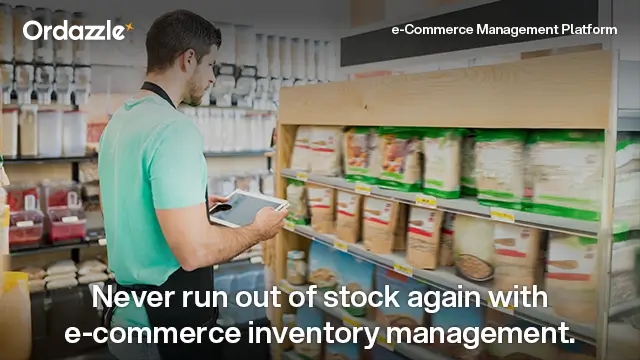How to Optimise Your Multichannel E-Commerce Strategy

The biggest problem with e-commerce is that you have to compete with several other brands and marketplaces to keep the attention of customers and have them make repeat purchases from your online store. In today’s digital era, having a strong e-commerce presence is a must for any business. Be it social media or marketplaces, video or static posts — you have to be all over it. The higher your visibility, the better it is.
But multiple channels, such as marketplaces, social media, and your own website, can be quite difficult to handle, especially if you use manual methods. This is where the genius of a multi-channel e-commerce platform comes in. If you plan to increase visibility at any point, you need to think about integrating a multi-channel e-commerce software into your system.
In this blog, we’ll explore what a multi-channel e-commerce strategy is, why it’s important to optimise it, and tips to do so effectively.
What is a multichannel e-commerce strategy?
Multichannel e-commerce strategies are gradually increasing in popularity. It is the practice of selling products on multiple platforms or channels. This can include marketplaces such as Amazon or Etsy, social media platforms like Instagram or Facebook, and your own website.
The logic is simple. By interacting with potential customers on multiple levels, you essentially increase your chance of leaving an impression. You can reach a wider audience, increase sales, and build brand awareness.
Remember, though, it is not enough to just implement a multi-channel e-commerce strategy; you need to optimise it frequently based on the results you see. By taking the time to evaluate and adjust your strategy, you can ensure that your efforts are focused on the right channels, products, and messaging. A good multichannel e-commerce platform can go a long way to streamlining your operations.
Key elements of a successful multi-channel e-commerce strategy
Identifying Your Target Market
One of the first steps in creating a successful multichannel e-commerce strategy is identifying your target market. This involves understanding who your customers are, what they’re interested in, and where they’re spending their time online.
By understanding these key elements, you can tailor your marketing efforts and choose the most effective channels to reach your audience.
Creating a Brand Identity and Consistent Message
This involves developing a unique voice and visual identity that resonates with your target market. By having a consistent message across all channels can help increase brand recognition and build trust with your customers.
Integration of Channels and Data
This is crucial for a successful omnichannel e-commerce strategy. It involves using a multichannel e-commerce platform that allows you to manage all your different sales channels in one place.
This ensures that data is consistent across all channels and there are none of the discrepancies that could arise from manual data entry. By having a central location for managing all channels, you can make data-driven decisions and optimise your strategy more effectively.
Personalisation of Customer Experience
Personalisation is becoming increasingly important in e-commerce. This involves using data and customer behavior to personalise product recommendations, promotions, and messaging. It is the extra step that you go to remind your customers that they matter and that they are special to you. Most multichannel e-commerce platforms have in-built features to assist you with this.
Measuring Success and Analyzing Data
This involves tracking key metrics, such as sales, traffic, and conversion rates across all channels. By analyzing this data, you can identify areas for improvement and adjust your strategy accordingly.
Apart from that, it is also important to regularly review and update your growth strategy to ensure that it is aligned with your evolving goals and needs.
Tips to optimise your multi-channel e-commerce strategy
Focus on customer experience
Focusing on customer experience is essential for a successful e-commerce brand. This involves understanding customer needs and preferences and tailoring the experience for individual customers and visitors. By using a good multichannel e-commerce platform, you can ensure a seamless, personalised experience across all channels. This can help to improve customer satisfaction and drive sales.
Identify key channels for your business
Not all channels are created equal, and it’s important to identify the key channels that are most effective for your business. This involves understanding where your target market spends their time online and which channels are most likely to drive sales.
Your multichannel e-commerce platform can help you identify the most effective channels. This will help you can save time and resources while still reaching your desired audience.
Optimise product listings
This involves using descriptive titles and detailed descriptions, high-quality images, and accurate pricing information. By optimising product listings, you increase the likelihood of attracting and converting customers across all channels.
Implement social media and content marketing
Social media and content marketing are powerful tools for driving traffic and building brand awareness. By creating engaging content and promoting it on social media channels, you can increase your reach and attract new customers.
Integrating a multichannel e-commerce platform into your e-commerce operations will provide a bird’s-eye view over your entire empire. You’ll be able to identify areas of high interaction and place your products accordingly.
Leverage automation tools
This can include using automated email marketing campaigns, chatbots for customer service, and tools for inventory management and order fulfillment.
Automating repetitive tasks is a sure method of saving on time and resources while still providing a high-quality customer experience.
Conclusion
Don’t underestimate the power of a multichannel e-commerce strategy for increasing your brand visibility. By identifying your target market, creating a strong brand identity, integrating channels and data, personalising the customer experience, and analyzing data, you can optimise your strategy.
But don’t manage the different channels separately. Implement a multichannel e-commerce platform and make your life easier. You can check out the channel management solution from Ordazzle to get started with more streamlined channel management operations.


